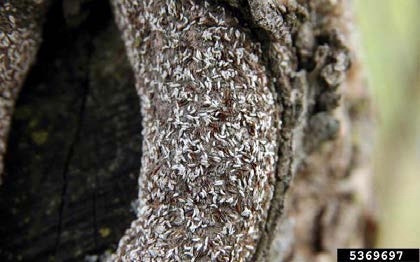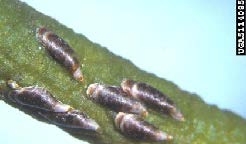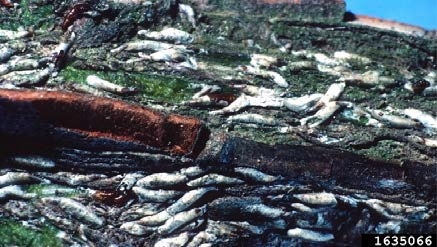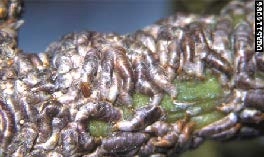Japanese Maple and Oystershell Scales in Residential Landscapes
ID
ENTO-550NP
Introduction
Japanese maple scale (Lopholeucaspis japonica; Fig. 1) and oystershell scale (Lepidosaphes ulmi; Fig. 2) are similar looking armored scale insects in the Family Diaspididae. Both Japanese maple and oystershell scales can be serious pests of a wide range of ornamental trees and shrubs in Virginia. Favored hosts include maples, dogwood, lilac, fruit trees, fruit trees, and willow. In addition, Japanese maple scale is also found on broadleaf evergreens such as holly, boxwood, and euonymus.


Armored scales are named for the hardened, waxy shield-like covering they secrete that protects the insect underneath. Most armored scale species overwinter as eggs beneath the cover of the mother scale. In spring, eggs hatch into tiny mobile crawlers that migrate to new feeding sites on infested hosts. After a few days, the crawlers settle, insert their mouthparts to feed, and begin secreting their protective covers. Adult female armored scales remain under their shield their entire life, but adult males, which superficially resemble winged aphids, emerge and fly to seek other females as mates.
Damage
Armored scale insects feed on plant cell contents with long, threadlike mouthparts 6-8 times longer than the insect’s body, which slowly reduces plant vigor. Due to their small size and cryptic nature, large populations of scales can flourish unnoticed before infested plants show visible damage symptoms. Heavily infested plants become discolored and grow poorly with twig and branch dieback. Sometimes an infested plant is so weakened that it loses its leaves and dies.
Japanese maple scale often settles in bark fissures or bark collars, which helps hide early infestations from sight (Figs. 1 & 3). Older infestations on heavily encrusted trunks and branches become apparent when darker colored bark appears whitewashed. Unmanaged oystershell scale populations can build up heavy layers with younger scales developing underneath older scales (Fig. 4). Infested twigs and bark may appear dark, uneven, and bumpy.


Identification
Both Japanese maple and oystershell scales look somewhat like the shell of an oyster, being pointed at one end and broader at the other; longer than wide; and often curved in shape. In addition, oystershell scale has curved parallel lines arcing from side to side (Fig. 2). The covering of the oystershell scale ranges in color from gray to brown. Oystershell scale has 1-2 generations per year and overwinters as pale eggs. The crawlers are a light-yellow color.
Japanese maple scale has a reddish-brown shield under a whitish coating that can be wiped off (Figs. 1 & 3); underneath, the mature female is a light purple color. Japanese maple scale can have several generations a year and overwinters as developing nymphs that mature in the spring and lay purple eggs. The crawlers are colored pink to purple.
Control
Since Japanese maple and oystershell scales can be mistaken for each other, accurate identification is needed for proper management. Consult your local Cooperative Extension office for assistance with scale identification and treatment recommendations.
Infested plants can be treated with dormant oil in late winter before bud break, or use a contact insecticide when crawlers are present. The waxy shields protect armored scales against most contact insecticides, so applications should be timed to target the naked crawlers before they settle. Electrical tape placed on branches with the sticky side up can used to determine when crawlers are active and pinpoint when contact insecticides would be most effective. Oystershell scale crawlers are usually present in April, May, and June. Japanese maple scale crawlers can be found throughout the warmer months.
Dinotefuran as a soil drench is more effective against Japanese maple and oystershell scales than other systemic insecticides such as imidacloprid. Dinotefuran may not be readily available for homeowner use; consult an arborist or pest control operator if necessary. Read insecticide labels carefully as some materials may cause phytotoxicity to maples and other sensitive trees.
Dead scales will remain on the plant until they weather off. Check for live scales before treatment by rubbing the waxy covers. Live scales release a liquid when crushed but dead scales remain dry. Several insecticide applications may be needed for good control of these scales, but dead scales do not warrant treatment.
When feasible, prune and destroy badly infested branches. Gently scrub scales from trunks and lower branches with a soft plastic brush, but take care not to damage thin-barked trees and shrubs.
Virginia Cooperative Extension materials are available for public use, reprint, or citation without further permission, provided the use includes credit to the author and to Virginia Cooperative Extension, Virginia Tech, and Virginia State University.
Virginia Cooperative Extension is a partnership of Virginia Tech, Virginia State University, the U.S. Department of Agriculture (USDA), and local governments, and is an equal opportunity employer. For the full non-discrimination statement, please visit ext.vt.edu/accessibility.
Publication Date
March 6, 2023



